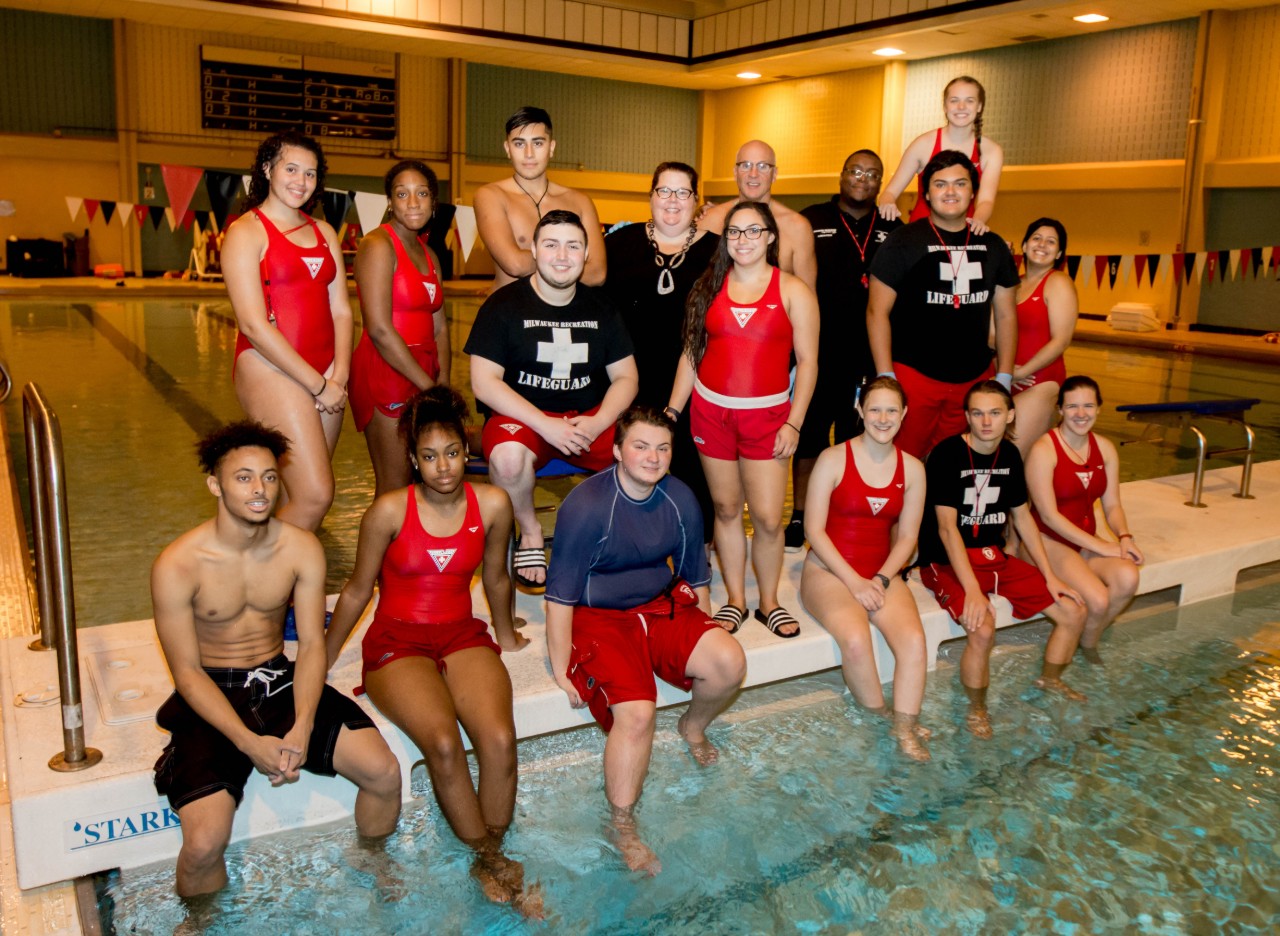Moving toward equity and applying an equitable lens … It takes investment, and it takes time.
In 2007, we at the Milwaukee Recreation Department, a part of Milwaukee Public Schools, began a seven-year effort to change the demographics of our aquatics staff to match that of our community. Our staff had a very narrow demographic: After performing an informal assessment, we established that approximately 95% of our staff were white individuals between 16 and 21 years of age. The primary part-time aquatics employee was a white high school or college student — that’s what was expected to be the target market for the position, and people rarely questioned that.
In addition to diversifying our staff, we continue working to bring swimming to a clientele that is more diverse in terms of race, income and region.
But it really does take time, because there are so many barriers to break down.
Community connection
Why was the staff 95% white and young? Where were these staff members coming from?
If we want to increase swimming among the poor and people of color, staffing at our aquatics facilities should more closely reflect our communities. I think it really comes down to trust. I can sit down next to a family and talk to an African-American mom while she has her children in class, and I can listen to her explain how she needs a swimming cap that won’t ruin her daughter’s hair. As a white, middle-aged woman, I don’t share that experience, so it might seem that I don’t have the connection to the community that she’s looking for. Then I look at one of our lifeguards — she’s an African American, a competitive swimmer, and she deals with her hair every day. She can sit down and say, “Here’s what I do with my hair before I start swimming.” The client is more likely to think, “She looks like me, she understands me, she’s a fantastic swimmer. I’m going to trust her.”
A sidenote: The hair issue does come up over and over, so we ordered swim caps made for long hair. They’re great for braids and dreadlocks. We sell them at our center for the same price as the regular swim caps, even though they cost us more. Small things like that can make a big difference. It sends a message that we care.
We knew we’d need to create a similar connection to attract lifeguards from Black and brown neighborhoods. When you don’t have many people of color on your team, you need to establish role models to reinforce the idea that this is a welcoming space. Then you form relationships from there. But this takes time, like planting seeds. You foster positive relationships with people, and then they go into the community and form more relationships. It’s like a ripple effect. It’s very genuine and grassroots.
In my third year with Milwaukee Recreation, I brought on a current partner of mine — Denzel Shareef, our aquatics supervisor — to assist with outreach efforts. He’s an African American who has an amazing ability to connect with high school students. Denzel was serving as head coach for both girls and boys swim teams, comprised of athletes from three different schools. He not only fostered relationships, but also recruited students who never thought they could swim well enough to join the team. That created quite a shift in the unspoken expectations of what it takes to join a swim team. Nobody had considered how we should accommodate non-swimmers. Then one day, these swimmers could become lifeguards, swim instructors and aquatics managers.
Removing barriers
We saw an obvious need to remove the obstacles that stand between people of color and aquatics. We tried some pilot programs — some worked, some not so much. But we eventually landed on an equation that enabled equity both on our staff and in our clientele.
Of course, one of the biggest obstacles is cost. Lifeguard and swim instructor jobs require training and certification — which carries a price tag. If you can spend $150 or $200 to take a lifeguard training class, you can get a decent-paying job. But if there’s not that extra couple hundred dollars lying around, what does that mean for you? We recognized that those burdens and obstacles kept the staff as it was.
We now offer lifeguard training for $35 — the cost of the certification card. We absorb the remaining cost. Then we have a scholarship fund if even the $35 fee presents too much of an obstacle. The scholarship fund is maintained through a fundraising event and the profits from concession-stand sales. Additionally, people can donate to the fund when they register for any Milwaukee Recreation course or activity.
It also really is about access. Before, there was only one place to train — the aquatics facility closest to our offices. If you couldn’t access that location, you wouldn’t have the opportunity to become a certified lifeguard. Having the training 1 mile away from where we work is convenient for us, but it’s not about us. So we offer a class on the opposite side of town each February. That alone has helped attract a more diverse pool of candidates. I would challenge other operators to consider that. We have a pretty robust public transportation system in Milwaukee, so we make sure to choose locations that are right on the bus line. We can offer bus tickets if they need them.
But we had to drill down even further. A lack of swimming skills presented a huge obstacle. Lifeguarding positions are great if you can swim. But those who can swim usually are people of privilege who’ve had the opportunity to take instruction. We partnered with our Teen Twilight Center Programs — hang-out centers available free of charge throughout the city — to provide practice sessions so students could develop the skills needed to qualify for our lifeguard-training opportunities. We very actively recruited for these programs.
We also cultivated the local swim teams as a way to spread swimming instruction and develop future lifeguards and safety instructors.
This was Denzel Shareef’s idea. The district says that each school only gets one head coach unless the team has 20 athletes, in which case you can get an assistant coach. Swimming was on the decline in our city, so many of the schools were down to a single coach. To incentivize the coaches to work with us, we drew more kids to the teams by opening them up to non-swimmers. We’d reserve the varsity teams for athletes who had previous experience and ability. When we met 20 athletes per team, the district allowed us to hire an assistant coach, who would handle the junior varsity team. We could hire somebody with a strong instructional background to create a culture where JV swim is an instructional activity. To motivate potential swimmers, we made the promise of lifeguarding jobs by the end of their first year.
Denzel made this happen through peer recruitment. He let the swimmers recruit their friends. Because of this, the program went from having no visibility to having the largest team in the city. One team that had never been a contender before suddenly came out of nowhere to win a conference championship. It was like one of those Hallmark movies!
Customer obstacles
Poverty is also the main obstacle for potential clients of our aquatics centers. The areas of greatest poverty had the lowest participation numbers — until we decided to change it.
When we go into communities that are impoverished, we find that swimming and water safety aren’t even on the radar of families, when just knowing where they’re going to live for the next month or how they’re going to eat are the priority.
We were able to bring the swim education fee down to $5 for an eight-session package that normally cost $36. This was largely made possible by the American Red Cross Centennial program, which pitched in $21 per student.Beyond that, we have a tiered pricing program where we automatically offer a $10 discount for qualifying families to participate in any program over $30. We also provide students with a swim cap, and we received a large donor gift to provide swimwear for people in need.
This made a huge difference. Before, it was difficult to put programming in the innermost parts of the city because of low attendance. Between the two centers in our two poorest neighborhoods, we struggled to recruit a combined 20 participants. With these changes and a targeted marketing push, we had 422 take part when we debuted last winter. Based on pure demand, we added two nights per week. In spring we set up 500 seats and sold those out in only two days. Unfortunately, COVID-19 put that on hold.
Worth the effort
It took about five years to see significant changes. It’s really wonderful how, once you extend those opportunities and invest in them, we can gain role models for the future generation of lifeguards, and things begin to cycle differently.
When we put all these pieces together, that saying truly becomes a reality: “If you build it, they will come.”



